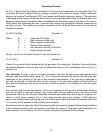27
Volumetric Flow Meters Under Pressure
V Series Volumetric Flow Meters are intended for use in low pressure applications. This is
because an accurate measurement of the volumetric ow rate by means of differential pressure
requires the ow at the differential pressure sensor to be in a laminar state. The state of the ow
is quantied by what is known as the Reynolds Number. If the Reynolds Number gets above a
certain point, generally accepted as approximately 2000, the ow will become non-laminar. The
Reynolds Number for a given Newtonian uid ow is dened as:
Re = ρVL/η
Where: ρ = density
V = average velocity
L = Constant determined by length and geometry of passage
η = absolute viscosity
From this relationship we see that increasing the gas density or velocity increases the Reynolds
Number, and increasing the gas viscosity decreases the Reynolds number. For a given gas in
a given meter at a given temperature, L and η are roughly xed constants.
For the purpose of illustration, let us put two 100 (S)LPM ow meters, identical in every way
except that one is a volumetric ow meter and one is a mass ow meter, in series with one
another in a pipeline. Now let us pass a small constant air ow through the meters, thus xing
the velocity V though both meters. With the ow xed, let us begin increasing the pressure,
and thus the density ρ. The mass ow meter, which is measuring the absolute pressure and
compensating for the density change registers this pressure increase as an increase in mass
ow rate because the number of molecules of gas keeps going up in the xed volume of ow.
In addition, the Reynolds number has increased proportionately with the pressure increase
because the density goes up with the pressure. If you increase the pressure high enough,
the mass ow meter will max out at 100 SLPM, the Reynolds number has increased fairly
dramatically, and the volumetric meter still registers your small xed ow rate.
Now if we maintain the higher pressure and try to take the volumetric meter up to its published
full scale ow of 100 LPM, our density ρ AND our velocity V will be high, which often results
in a high Reynolds number and non-laminar ow. When the ow is non-laminar, the Poiseuille
Equation upon which we base our volumetric ow measurement is no longer valid and the
meter reading is therefore no longer valid.
Gas properties also need to be taken into account in deciding whether you can use a volumetric
ow meter at a particular line pressure. Helium, which has a relatively low density and a
relatively high viscosity at standard conditions, can generally get away with higher pressures in
a volumetric ow meter. Propane, on the other hand, has a relatively high density and relatively
low viscosity making it a considerably more difcult gas to measure at higher pressures in a
volumetric ow meter. In air, most volumetric meters make valid full scale measurements up to
10-15 PSIG line pressure.


















